William Lee Conley Broonzy
b. June 26th, 1898 in Scott (Mississippi) or Lake Dick (Arkansas)
d. August 15th, 1958 in Chicago (Illinois)
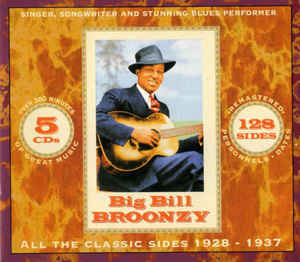
ALL THE CLASSIC SIDES
JSP
October 1928 - January 1937
Né dans une famille de 17 enfants, il est le fils de Frank Broonzy et Mittie Belcher. D'après les dernières recherches de Robert Reisman, il serait né en Arkansas et non pas dans le Mississippi. Sa date de naissance (1898 ou 1903) semble aussi hypothétique. Quoi qu'il en soit, Bill passe son enfance à Pine Bluff (Arkansas) où il commence à apprendre le violon (d'abord fabriqué à partir d'une boite à cigares). Il chante avec son oncle Jerry Belcher puis s'associe avec son ami Louis Carter, qui joue de la guitare, et se produisent ensemble dans la région. Il passe deux ans dans l'armée (1917-19) et participe à la première guerre mondiale en Europe. Démobilisé en 1919, Bill revient à Pine Bluff. Peu après, il s'installe à Little Rock puis finalement à Chicago en 1920. Une fois à Chicago, il abandonne le violon et apprend la guitare avec "Papa" Charlie Jackson tout en exerçant différents métiers qui lui permettent de subsister (ouvrier, cuisinier, gardien). Par l'entremise du même "Papa" Charlie Jackson, Bill décroche une audition chez Paramount devant le producteur J. Mayo Williams. Il grave ses premiers morceaux en novembre 1927 entre Ragtime et Blues. Il y développe un remarquable jeu de guitare sophistiqué et mélodique appelé parfois flat-picking. Eclectique, ouvert à tous les styles, il devient rapidement capable de tous jouer. Dans ces premières années, on peut ressortir "House rent stomp", "Pig meat strut", "Big Bill blues", "Black cat rag". En 1934, Bill passe chez Bluebird (une marque de RCA-Victor) et enregistre avec le pianiste Black Bob sous la supervision du producteur Lester Melrose. Petit à petit, sa renommée grandit et il devient un des meilleurs bluesmen du South Side. Bill y est d'abord accompagné des pianistes Jimmie Gordon puis Black Bob et du contrebassiste Bill Settles.
Born into a family of 17 children, he is the son of Frank Broonzy and Mittie Belcher. According to Robert Reisman's latest research, he was born in Arkansas and not in Mississippi. His birth date (1898 or 1903) also seem hypothetical. However that may be, Bill spent his childhood in Pine Bluff (Arkansas) where he began learning the violin (first made from a cigar box). He sings with his uncle Jerry Belcher and then partners with his friend Louis Carter, who plays guitar, and perform together in the area. He spent two years in the army (1917-19) and participated in the first world war in Europe. Demobilized in 1919, Bill returns to Pine Bluff. Soon after, he moved to Little Rock and finally Chicago in 1920. Once in Chicago, he left violin and learned the guitar with "Papa" Charlie Jackson while practicing different jobs that allow him to subsist (worker, cook, guardian). Through the same "Papa" Charlie Jackson, Bill wins an audition at Paramount in front of producer J. Mayo Williams. He made his first songs in november 1927 between Ragtime and Blues. He develops a remarkable and sophisticated melodic guitar playing sometimes called flat-picking. Eclectic, open to all styles, he quickly becomes able to play all kind of songs. In these early years, we can highlight "House rent stomp", "Pig meat strut", "Big Bill blues", "Black cat rag". In 1934, Bill went to Bluebird (a RCA-Victor imprint) and recorded with pianist Black Bob under the supervision of producer Lester Melrose. Little by little, his fame grew up and he became one of South Side's best bluesmen. Bill is first accompanied by pianists Jimmie Gordon and Black Bob and bassist Bill Settles.
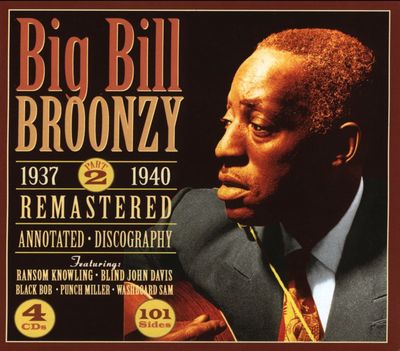
1937 - 1940
JSP
January 1937 - April 1940
Dans les années 30 et 40 chez Bluebird, il participe à des centaines de séances - en plus des siennes - pour de nombreux autres bluesmen et blueswomen (Memphis Slim, Lil' Green, Doctor Clayton, John Lee "Sonny Boy" Williamson, "Jazz" Gillum) créant le fameux Bluebird Sound, première incarnation du Chicago Blues orchestral. En parrallèle, Broonzy deviendra pour Bluebird une sorte de superviseur / producteur / arrangeur organisant les auditions, composant les morceaux, assemblant les orchestres. Ces faces symbolisent la création du Chicago Blues orchestral avec ses musiciens réguliers : Bill Settles, Ransom Knowling, Buster Bennett, Fred Williams, Black Bob, Blind John Davis, Joshua Altheimer. De nombreux chefs d'oeuvre (parfois déclinés en plusieurs prises alternatives qui peuvent paraitre rébarbatives) où Bill montre ses talents de guitariste, de chanteur et de compositeur : "Louise Louise", "Play your hand", "Somebody's got to go", "Good boy", "Border blues", "It's a lowdown dirty shame", "New shake 'em on down", "Going back to Arkansas", "Don't you want to ride", "Just a dream". On note aussi qu'en 1938, Bill joue le rôle de Robert Johnson dans la célèbre revue musicale "From spirituals to swing" produite par John Hammond.
In the 30's and 40's at Bluebird, he participated in hundreds of sessions - in addition to his own - for many other bluesmen and blueswomen (Memphis Slim, Lil' Green, Doctor Clayton, John Lee "Sonny Boy" Williamson, "Jazz" Gillum) creating the famous Bluebird Sound, the first incarnation of the orchestral Chicago Blues. In parallel, Broonzy will become for Bluebird a kind of supervisor / producer / arranger organizing sessions, composing songs, assembling orchestras. These sides symbolize the creation of the orchestral Chicago Blues with his regular musicians : Bill Settles, Ransom Knowling, Buster Bennett, Fred Williams, Black Bob, Blind John Davis, Joshua Altheimer. Many masterpieces (sometimes declined in several alternative takes that may seem boring) where Bill shows his skills as a guitarist, singer and composer : "Louise Louise", "Play your hand", "Somebody's got to go", "Good boy", "Border blues", "It's a lowdown dirty shame", "New shake 'em on down", "Going back to Arkansas", "Don't you want to ride", "Just a dream". We also note that in 1938, Bill plays the role of Robert Johnson in the famous musical review "From spirituals to swing" produced by John Hammond.
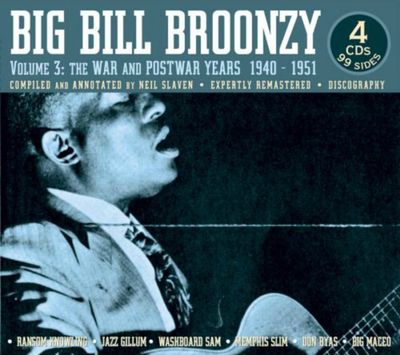
THE WAR AND POSTWAR YEARS
JSP
June 1940 - December 1951
En tant que pionnier et concepteur du Chicago Blues, Big Bill Broonzy reste, au début des années 40, un remarquable compositeur de pièces orchestrales pleines de verve et d'inspiration. Derrière lui, les meilleurs sidemen de la ville sont présents : Ransom Knowling, Memphis Slim, Big Maceo, Jazz Gillum, Fred Williams, Judge Riley, Washboard Sam, Ernest "Big" Crawford. D'excellents morceaux voient le jour comme "Midnight steppers", "You better cut that out", "Bed time blues", "Getting older every day", "Rockin' chair blues", "Key to the highway", "Wee wee hours", "What's wrong with me". Après un temps d'absence (dû notamment au Petrillo's ban), il reprend la route des studios en 1945 avec encore quelques beaux moments : "Oh baby", "Roll dem bones". Mais son rythme d'enregistrement baisse inéxorablement, il apparait de moins en moins en studio et se montre aussi moins globalement moins inspiré. Pour Columbia et Mercury, Bill opte souvent pour un style Rhythm & Blues avec des cuivres ("Sax" Mallard, Johnny Morton, Bill Casimir).
As a pioneer and designer of the Chicago Blues, Big Bill Broonzy remains, in the early 40's, a remarkable composer of orchestral tracks full of verve and inspiration. Behind him, the best sidemen of the city are present : Ransom Knowling, Memphis Slim, Big Maceo, Jazz Gillum, Fred Williams, Judge Riley, Washboard Sam, Ernest "Big" Crawford. Great songs come out such as "Midnight steppers", "You better cut that out", "Bed time blues", "Getting older every day", "Rockin' chair blues", "Key to the highway", "Wee wee hours", "What's wrong with me". After a time of absence (due in particular to Petrillo's ban), he took again the road of the studios in 1945 with still some beautiful moments : "Oh baby", "Roll dem bones". But his recording rate is declining inexorably, he appears less and less in studio and is also globally less and less inspired. For Columbia and Mercury, Bill often opts for a Rhythm & Blues with horns ("Sax" Mallard, Johnny Morton, Bill Casimir).
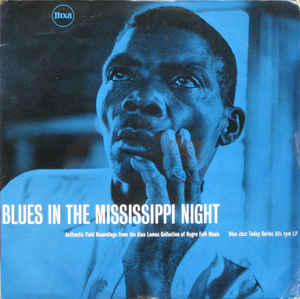
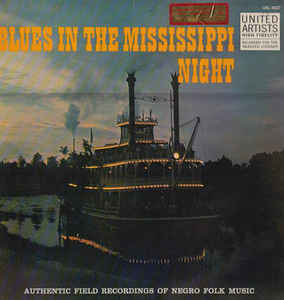
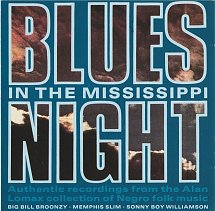
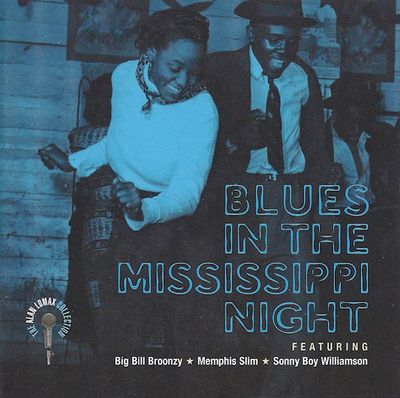
BLUES IN THE MISSISSIPPI NIGHT
Nixa
Rykodisc
Sequel
Rounder
March 1947
Le folkloriste Alan Lomax enregistre en 1947 Memphis Slim, Big Bill Broonzy et "Sonny Boy" Williamson dans les studios Decca pour le documentaire "The art of the negro" (qui deviendra "Blues in the Mississippi night"). Il s'agit d'un recueil de chansons, de conversations, de souvenirs des trois bluesmen qui prennent visiblement plaisir à jouer ensemble, improvisant même parfois. Ce programme intéressant a connu plusieurs éditions sensiblement différentes. Big Bill Broonzy joue notamment son "Black brown and white blues".
Folklorist Alan Lomax recorded Memphis Slim, Big Bill Broonzy and "Sonny Boy" Williamson in 1947 at Decca studios for the documentary "The art of the negro" (which will become "Blues in the Mississippi night"). It is a collection of songs, conversations, memories of the three bluesmen who visibly enjoy playing together, sometimes even improvising. This interesting program has gone through several significantly different editions. Big Bill Broonzy particularly plays his "Black brown and white blues".
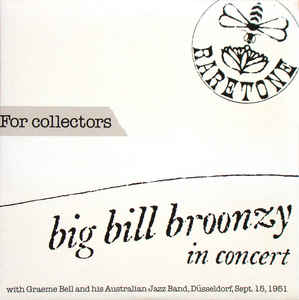
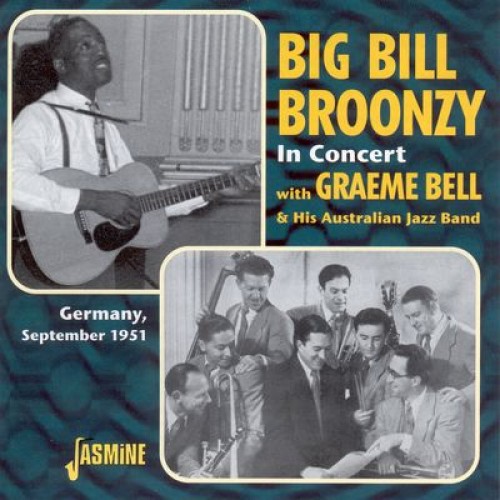
IN CONCERT WITH GRAEME BELL
Raretone
Jasmine
September 1951
Ce disque est historiquement important car il capte Big Bill Broonzy lors de son premier voyage européen en 1951 (il fut un des premiers bluesmen à traverser l'Atlantique à l'instar de Leadbelly). Il s'agit d'un concert en Allemagne avec le groupe du pianiste de jazz australien Graeme Bell. On n'entend, en fait, Bill que sur huit titres : quatre seul à la guitare et quatre autres avec le jazz-band pré-cité. Un ensemble un peu bancal qu'on conseillera surtout aux inconditionnels de Broonzy.
This record is historically important because it captures Big Bill Broonzy during his first European trip in 1951 (he was one of the first bluesmen to cross Atlantic like Leadbelly). This is a concert in Germany with the band of Australian jazz pianist Graeme Bell. In fact, we only hear Bill on eight tracks : four alone on guitar and four with the pre-cited jazz band. A somewhat wobbly set that will be recommended especially to Broonzy's confirmed fans.
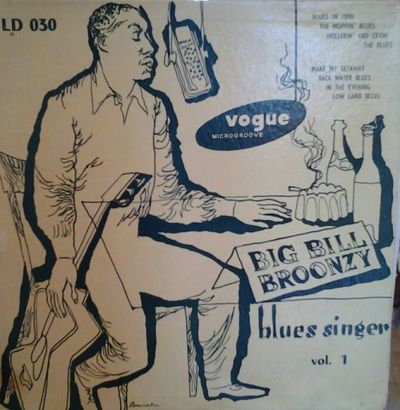
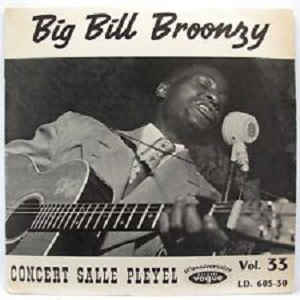
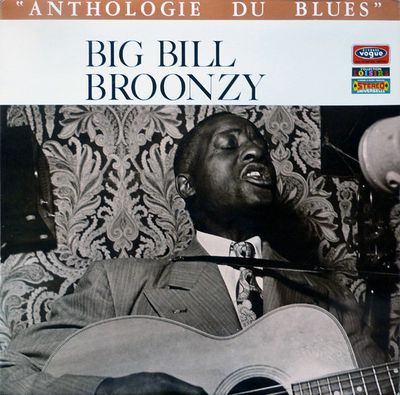
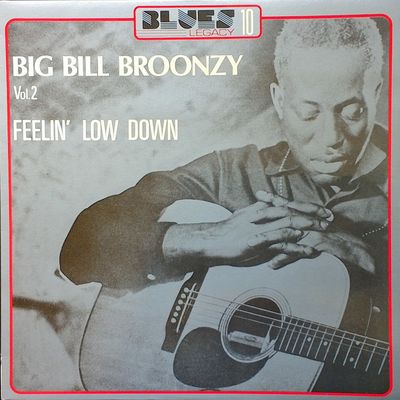
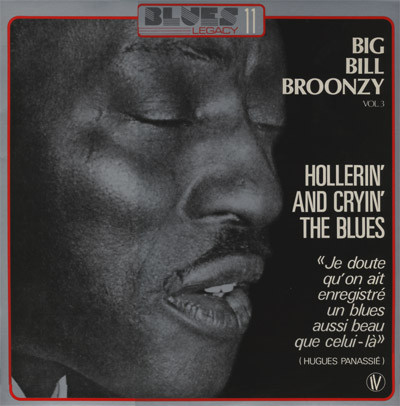
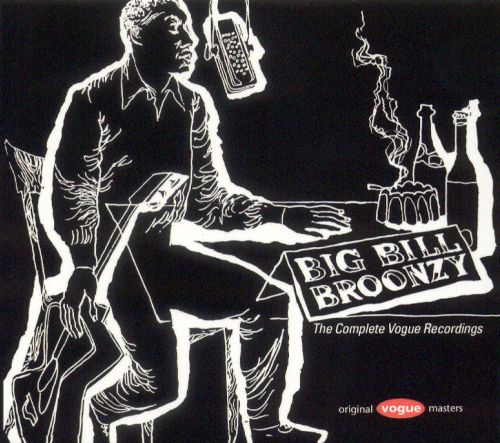
BLUES SINGER vol.1
Vogue
SALLE PLEYEL
Vogue
ANTHOLOGIE DU BLUES vol.2
Vogue
FEELIN' LOW DOWN
Vogue
HOLLERIN' AND CRYIN' THE BLUES
Vogue
THE COMPLETE VOGUE RECORDINGS
Vogue
September 1951 - March 1952
Les tournées en Europe que fit Big Bill Broonzy permirent en leur temps de faire connaitre le Blues au-delà des Etats-Unis. Grâce à l'appui notable d'Hugues Panassié, Bill enregistra substantiellement pour le label français Vogue, plusieurs séances studio et un album en concert à la Salle Pleyel, en 1951 et 1952. Il propose des titres situés entre Blues, airs traditionnels ou religieux. Si cette oeuvre n'est pas au même niveau que sa production chicaogane légendaire des années 30 et 40, elle reste, néanmoins, historiquement importante et mérite une écoute attentive.
Big Bill Broonzy's european tours helped to spread the blues beyond the United States. Thanks to the significant support of Hugues Panassié, Bill recorded extensively for the french label Vogue, including several studio sessions and a live album at the Salle Pleyel, in 1951 and 1952. He plays tracks ranging from blues to traditional and religious tunes. While this work is not on the same level as his legendary Chicago output of the 1930's and 1940's, it nevertheless remains historically important and deserves careful listening.
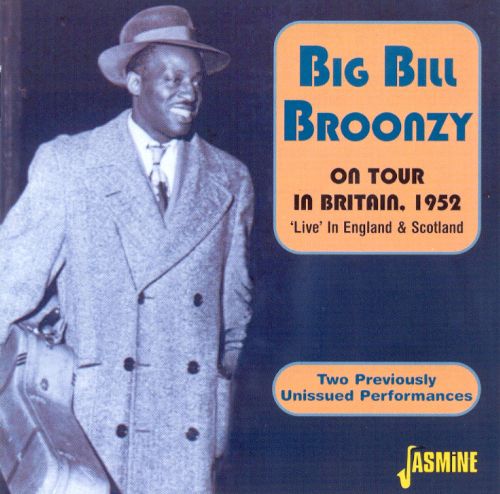
ON TOUR IN BRITAIN
Jasmine
February / December 1952
Deux concerts inédits réunis en CD par le label Jasmine. Ils ont été captés en Ecosse et en Angleterre pendant l'année 1952. Bill apparait seul à la guitare dans la veine Folk-Blues qui caractérisera la dernière partie de sa carrière. Quelques bons moments mais le programme semble souvent monotone voire fastidieux : il faut dire que les nombreuses interventions parlées de Bill font systématiquement retomber le rythme des concerts.
Two unreleased concerts gathered on CD by the label Jasmine. They were captured in Scotland and England in 1952. Bill appears alone on guitar in the Folk-Blues vein that will characterize the latter part of his career. Some good moments but the program often seems monotonous even tedious : it must be said that the many spoken interventions by Bill systematically spoil the rhythm of concerts.
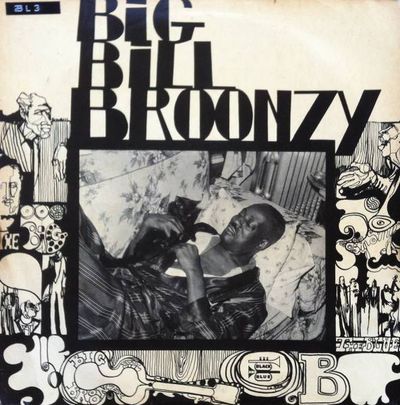
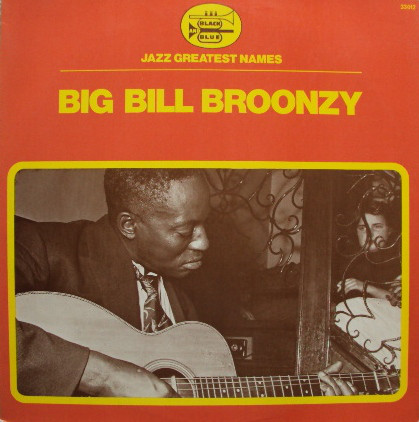
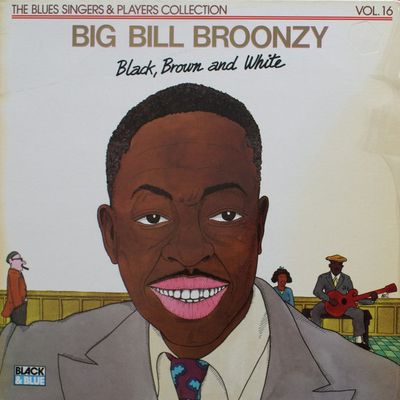
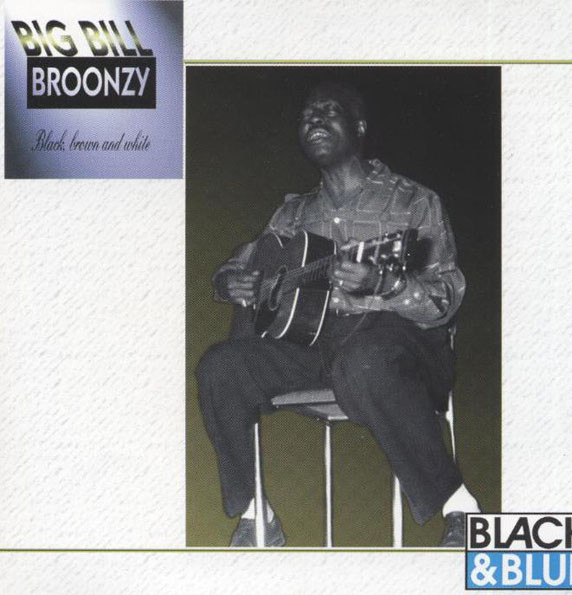
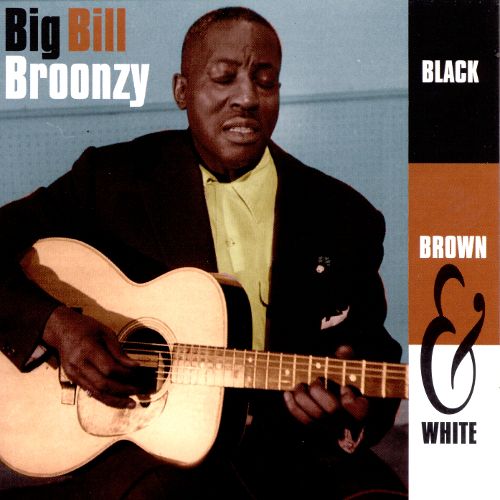
BLACK BROWN AND WHITE
Black & Blue
Evidence
May 1952 / December 1955
Cet album est composé d'une partie live et d'une partie studio. La première partie présente Bill sur une scène d'Anvers en Belgique en mars 1952. Il délivre une sympathique performance parfois accompagné du pianiste Blind John Davis. Broonzy brille notamment sur "Lowland blues" et "Going to Chicago". La seconde partie fut enregistrée en décembre 1955 par Yannick Bruynoghe à son domicile à Bruxelles. Bill y chante quelques beaux blues dans une ambiance relachée et intime.
This album is composed of a live part and a studio part. The first part presents Bill on stage in Antwerp in Belgium in march 1952. He delivers a nice performance sometimes accompanied by pianist Blind John Davis. Broonzy shines notably on "Lowland blues" and "Going to Chicago". The second part was recorded in december 1955 by Yannick Bruynoghe at his home in Brussels. Bill sings some beautiful blues in a relaxed and intimate atmosphere.
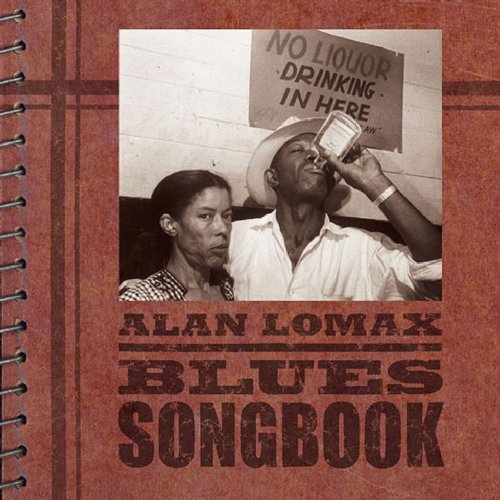
ALAN LOMAX BLUES SONGBOOK
Rounder
May 1952
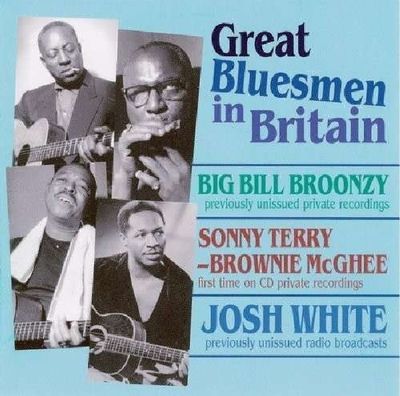
GREAT BLUESMEN IN BRITAIN
Avid
1952
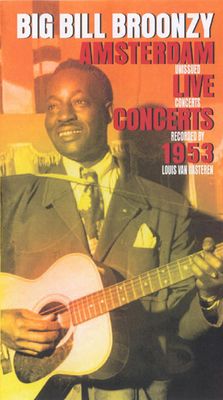
AMSTERDAM LIVE CONCERTS
Munich
February 1953
Deux concerts à Amsterdam enregistrés par Louis Van Gasteren possédant les mêmes qualités et défauts que le CD Jasmine paru précédemment. Broonzy chante son répertoire Folk-Blues habituel, de manière compétente mais routinière. On remarque tout de même une prise de son très satisfaisante et un livret vraiment intéressant.
Two concerts in Amsterdam recorded by Louis Van Gasteren with the same qualities and defects as the Jasmine CD previously issued. Broonzy sings his usual Folk-Blues repertoire, competently but routinely. We still notice a very satisfactory sound and a really interesting booklet.
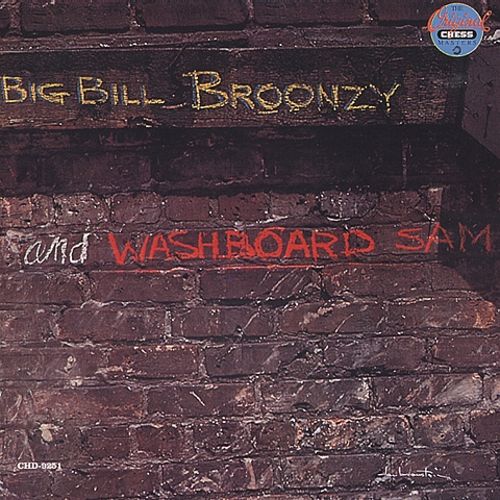
BIG BILL BROONZY AND WASHBOARD SAM
Chess
May 1953
Séance pour Chess de mai 1953 associant Big Bill Broonzy, son demi-frère Washboard Sam, le guitariste Lee Cooper et Ernest "Big" Crawford à la contrebasse. Mais, il manque un peu de flamme et d'inspiration de la part des deux leaders qui ont déjà fait beaucoup mieux par ailleurs. Set-list très inégale, assez déconcertante par moments. Bill semble, d'ailleurs, un peu absent, chantant sur quatre titres et jouant discrètement à la guitare sur quelques autres.
May 1953 Chess session featuring Big Bill Broonzy, his half-brother Washboard Sam, guitarist Lee Cooper and Ernest "Big" Crawford on bass. But, it lacks a bit of flame and inspiration from the two leaders who have already done much better elsewhere. Very uneven set-list, quite disconcerting at times. Bill seems, moreover, a little absent, singing on four tracks and playing discreetly guitar on a few others.
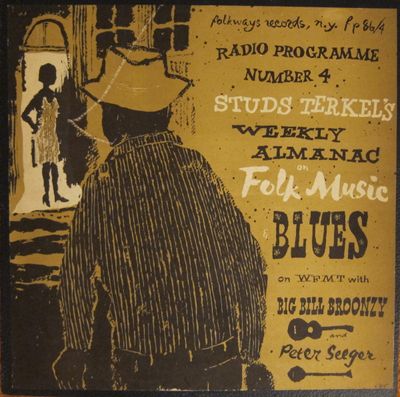
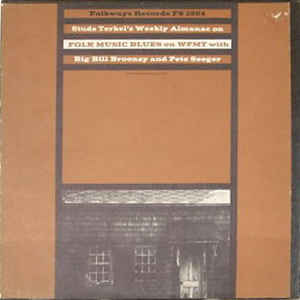
STUDS TERKEL'S WEEKLY ALMANAC
Folkways
1954
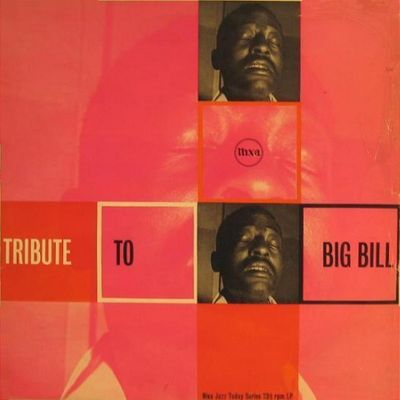
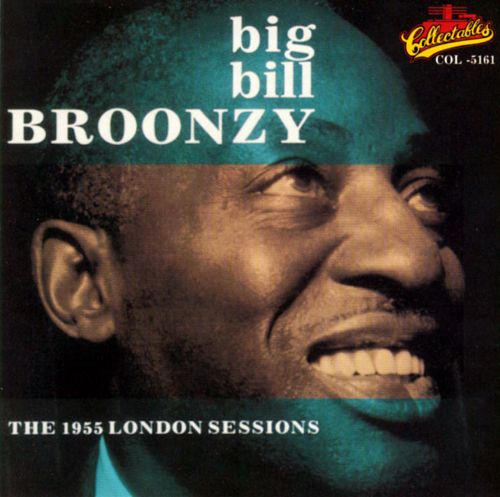
TRIBUTE TO BIG BILL
Nixa
THE 1955 LONDON SESSIONS
Collectables
October 1955
Séances londoniennes présentant Bill seul à la guitare et sur deux excellentes pistes ("It feels so good", "Southbound train") accompagné d'un orchestre complet. Programme assez correct montrant toujours un remarquable guitariste et un chanteur à la voix véhémente et expressive ("Mindin' my own business", "When do I get to be called a man", "Glory of love").
London sessions featuring Bill alone on guitar and on two excellent tracks ("It feels so good", "Southbound train") accompanied by a full orchestra. Quite decent program always showing a remarkable guitarist and a singer with a powerful and expressive voice ("Mindin' my own business", "When do I get to be called a man", "Glory of love").
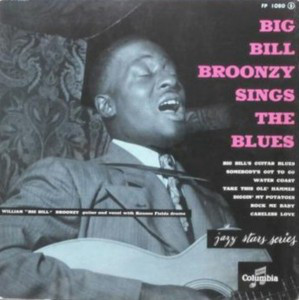
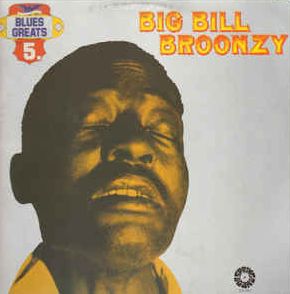
BIG BILL BROONZY SINGS THE BLUES
Columbia
BLUES GREATS vol.5
Metronoma
February 1956
Ce disque fut gravé à Paris pour le compte de Columbia. Bill est supporté uniquement par le batteur Carl "Kansas" Fields qui procure un bon contrepoint à son chant et sa guitare. Une séance plutôt sympathique avec de bons moments ("Big Bill's guitar blues", "Somebody's got to go", "Careless love").
This record was recorded in Paris on behalf of Columbia. Bill is supported only by drummer Carl "Kansas" Fields who provides a good counterpoint to his vocals and guitar. A rather nice session with good moments ("Big Bill's guitar blues", "Somebody's got to go", "Careless love").
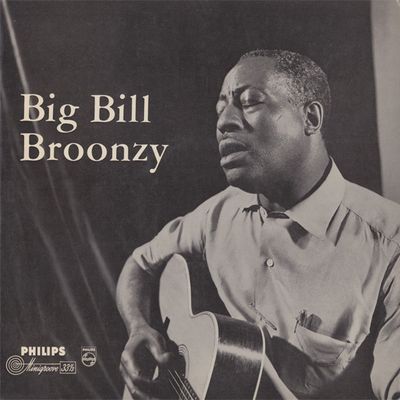
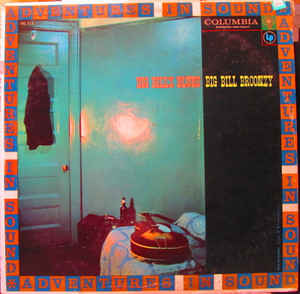
BIG BILL BROONZY
Philips
BIG BILL'S BLUES
Columbia
February 1956
Une séance austère et soporifique prise aux Pays Bas. Bill interprète ses titres habituels entre Blues, airs folkloriques et pièces religieuses.
Austere and soporific session taken in the Netherlands. Bill interprets his usual titles between Blues, folk tunes and religious pieces.
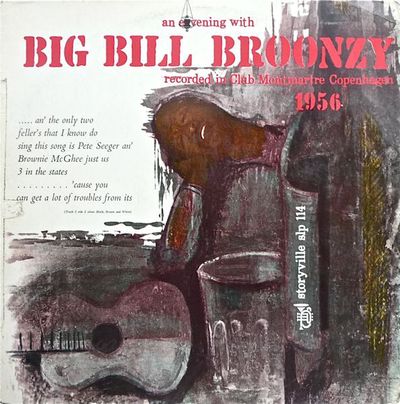
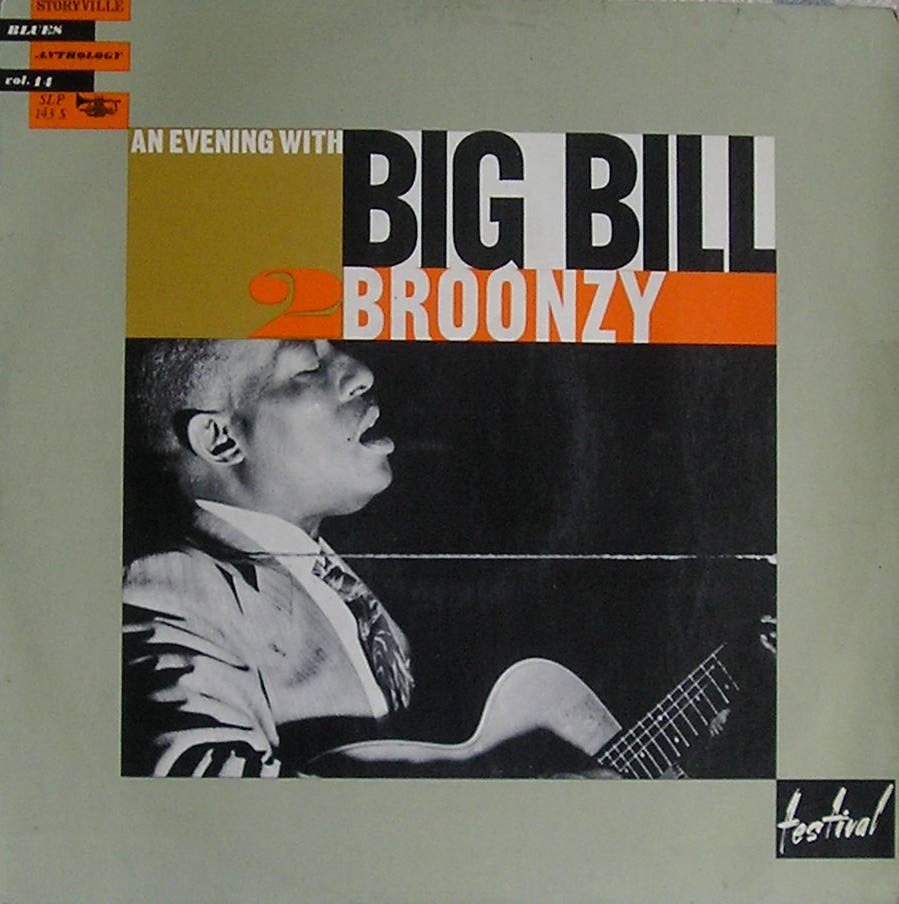
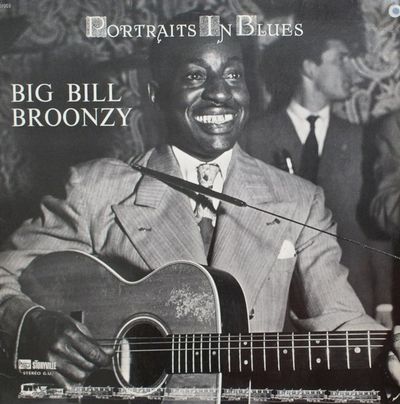
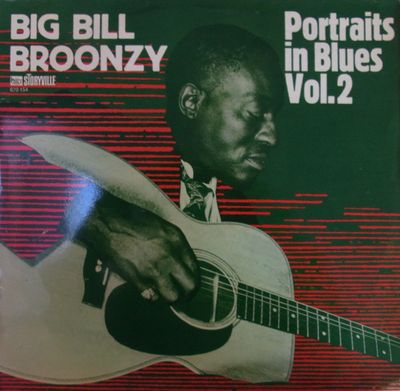
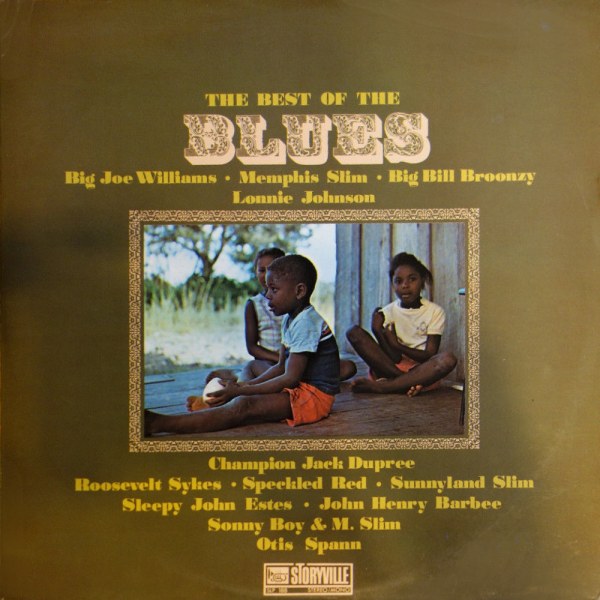
AN EVENING WITH BIG BILL BROONZY vol.1 & 2
PORTRAITS IN BLUES vol.1 & 2
THE BEST OF THE BLUES
Storyville
May 1956
Concerts dans un club de Copenhague au Danemark, lors d'un voyage européen, publié par le label local Storyville (fondé par Karl-Emil Knudsen). Bill passe en revue son répertoire habituel entre Ragtime et Blues, airs folkloriques et traditionnels ("Down by the riverside", "Ananias", "Black brown and white"). On trouve aussi quelques belles pièces à la guitare comme "Barrelhouse shuffle", "Guitar blues" et "Somebody love me". Impérial à la guitare, Bill livre une prestation parfois routinière mais globalement enjouée. Ces concerts ont donné lieu à différentes éditions LP/CD.
Concerts in a Copenhagen club in Denmark during a European trip, issued by the local record label Storyville (founded by Karl-Emil Knudsen). Bill reviews his usual repertoire between Ragtime and Blues, folk and traditional tunes ("Down by the riverside", "Ananias", "Black brown and white"). There are also some nice guitar moments like "Barrelhouse shuffle", "Guitar blues" and "Somebody love me". Imperial on guitar, Bill delivers a performance that is sometimes routine but globally cheerful. These concerts gave rise to different LP/CD issues.
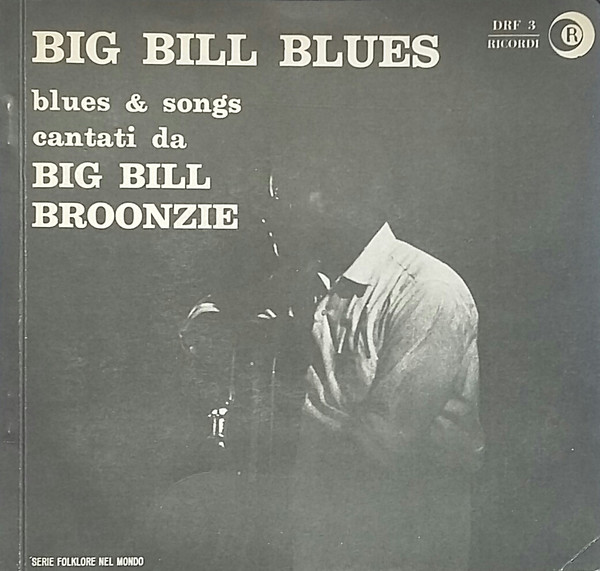
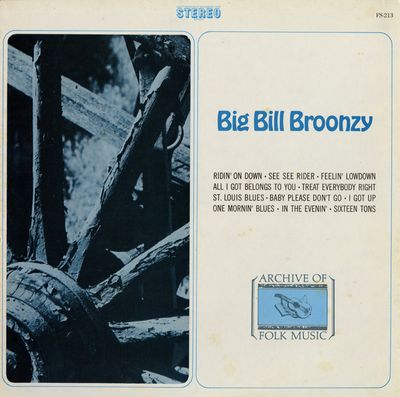
BIG BILL BLUES (EP)
Ricordi
BIG BILL BROONZY
Everest
June 1956
Capté dans un studio italien, cet EP a été repris dans différents LP chez Tradition, Musidisc ou Columbia. On trouve deux bons instrumentaux "St Louis blues" et "See see rider".
Captured in an Italian studio, this EP has been included in various LP on Tradition, Musidisc or Columbia. There are two good instrumentals "St Louis Blues" and "See see rider".
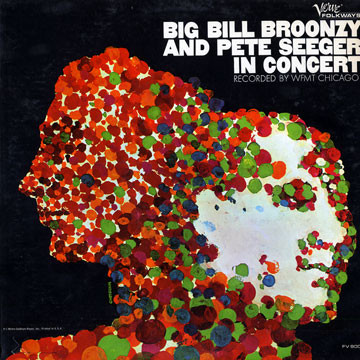
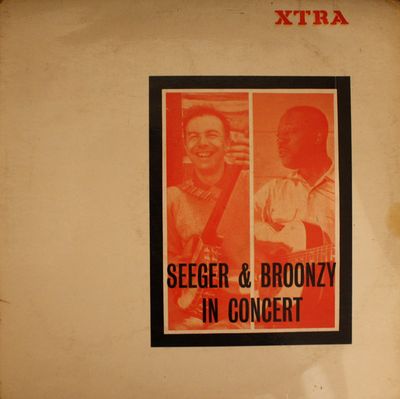
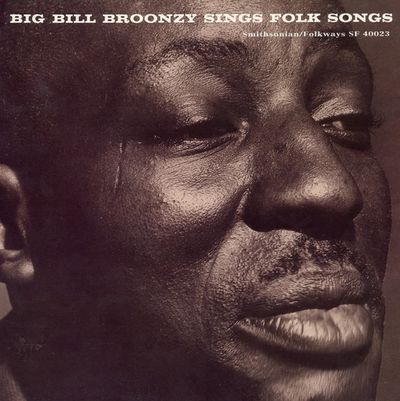
BIG BILL BROONZY AND PETE SEEGER IN CONCERT
Verve
IN CONCERT
Xtra
1956
BIG BILL BROONZY SINGS FOLK SONGS
Folkways
1956 / October 1957
Concert enregistré à la North Western University par la radio WFMT rassemblant Big Bill Broonzy et le folkloriste Pete Seeger publié sur le label Folkways de Moses Asch. Un répertoire majoritairement Folk avec un peu de Blues. En fait, les deux hommes jouent assez peu ensemble (sur deux morceaux seulement). La réédition Folkways "Big Bill Broonzy sings folk songs" reprend uniquement les pistes chantées par Broonzy et ajoute les derniers titres de sa carrière, gravés en octobre 1957 à Chicago.
Concert recorded at North Western University by WFMT radio gathering Big Bill Broonzy and folklorist Pete Seeger issued on Moses Asch's Folkways label. A predominantly Folk repertoire with a bit of Blues. In fact, the two men play very little together (on two pieces only). The Folkways reissue "Big Bill Broonzy sings folk songs" only picks up the tracks sung by Broonzy and adds the last tracks of his career, recorded in october 1957 in Chicago.
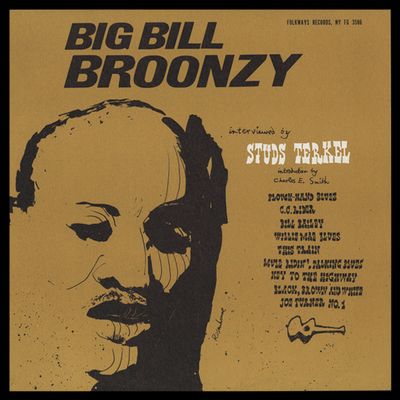
HIS STORY
Folkways
November 1956
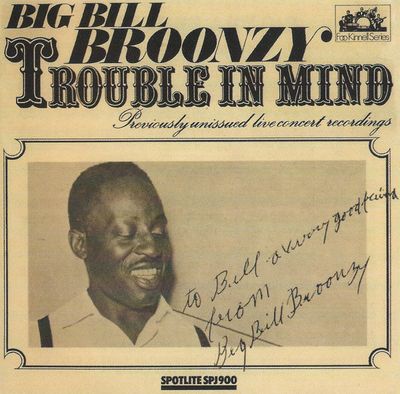
TROUBLE IN MIND
Spotlite
March 1957
Transcription d'un concert à Nottingham en Angleterre. Une performance sympathique parfois plate dans laquelle Bill joue ses titres usuels. Un disque à conseiller aux fans confirmés.
Transcription of a concert in Nottingham, England. A nice but sometimes flat performance in which Bill plays his usual titles. A disc to advise to confirmed fans.
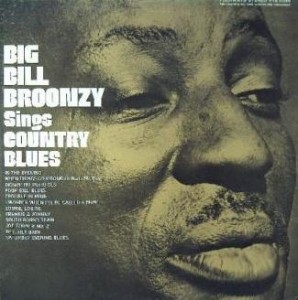
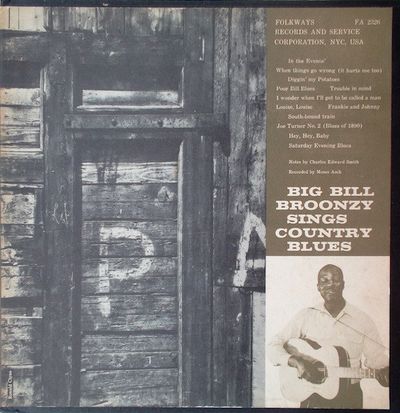
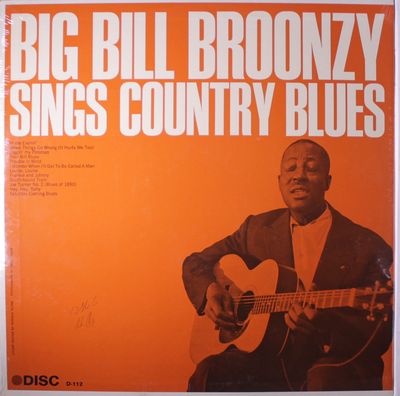
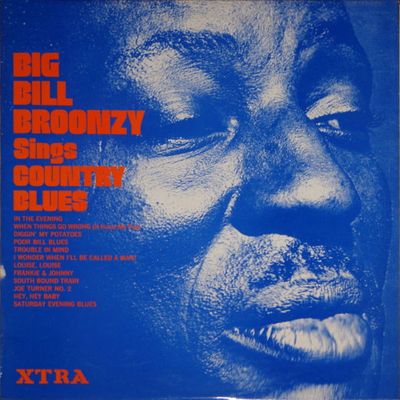
BIG BILL BROONZY SINGS COUNTRY BLUES
Folkways
Xtra
?
Une séance new-yorkaise pour Folkways agréable mais peu originale. Quelques bons moments Folk-Blues comme "In the evening", "Trouble in mind", "Louise Louise", "Hey hey baby".
A New York session for Folkways, nice but not very original. Some good Folk-Blues moments like "In the evening", "Trouble in mind", "Louise Louise", "Hey hey baby".
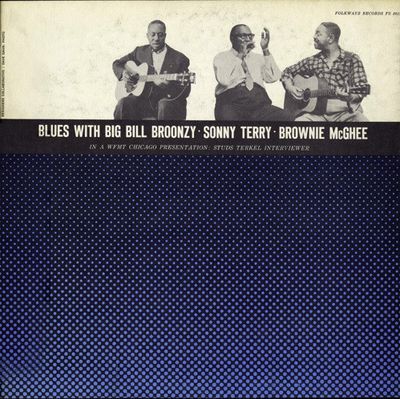
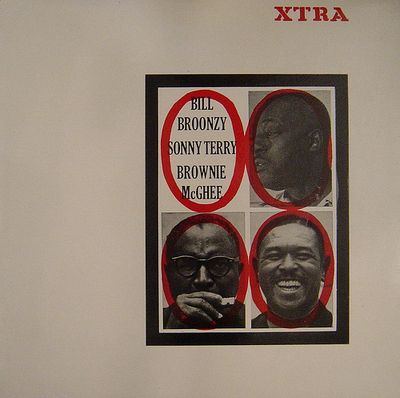
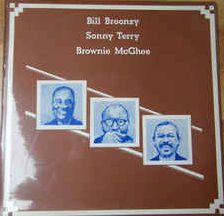
BLUES WITH BIG BILL BROONZY, SONNY TERRY AND BROWNIE MAC GHEE
Folkways
BIG BILL BROONZY, SONNY TERRY AND BROWNIE MAC GHEE
Xtra
THIS IS THE BLUES
Blue Angel
May 1957
Association de Big Bill Broonzy avec Brownie Mac Ghee et Sonny Terry enregistrée pour la radio WFMT et publiée en disque par Folkways. Des pistes Folk et Blues entrecoupées d'interviews menées par Louis "Studs" Terkel. Il y a une sorte d'émulation entre les trois artistes procurant une chaude atmosphère et une belle inspiration. Un document très intéressant.
Association of Big Bill Broonzy with Brownie Mac Ghee and Sonny Terry recorded for WFMT radio and issued on record by Folkways. Folk and Blues tracks interspersed with interviews conducted by Louis "Studs" Terkel. There is a kind of emulation between the three artists providing a warm atmosphere and a beautiful inspiration. A very interesting document.
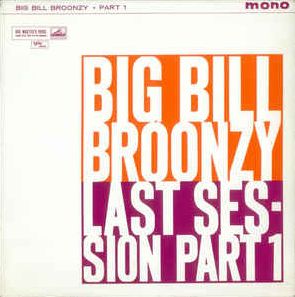
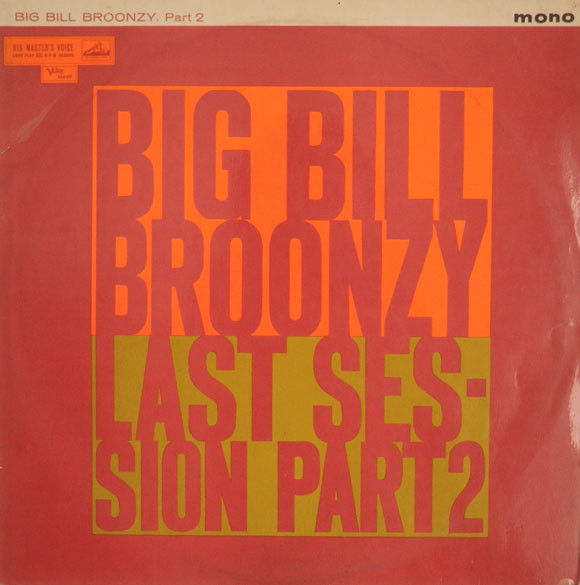
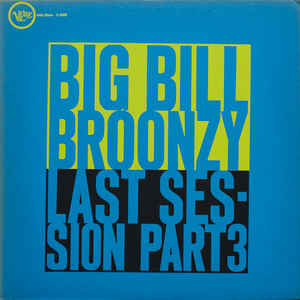
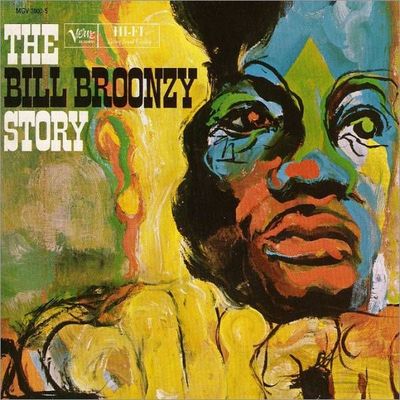
LAST SESSION vol. 1, 2 & 3
Verve
THE BILL BROONZY STORY
Verve
July 1957
Contrairement à ce que laisse penser le titre, il ne s'agit pas de sa dernière séance d'enregistrement (c'est l'avant dernière). Cette longue séance fut produite par le journaliste Bill Randle. Elle a duré plus de dix heures et a fait l'objet d'un recueil de 5 LPs (réédités plus tard en 3 CDs). Il s'agit d'un véritable document sur le Blues de Big Bill Broonzy alternant la musique et les témoignages du bluesman. Par conséquent, il vaudra mieux le conseiller aux fans confirmés. On retient plusieurs bons moments comme "Key to the highway", "Saturday evening blues", "Trouble in mind", "Joe Turner blues", "Backwater blues" parmi d'autres. On signalera aussi que dans les dernières années de sa vie, il écrit son autobiographie avec l'aide du belge Yannick Bruynoghe ("Big Bill blues").
Contrary to what the title suggests, this is not his last recording session (this is the penultimate). This long session was produced by journalist Bill Randle. It lasted more than ten hours and was the subject of a collection of 5 LPs (reissued later in 3 CDs). This is a true document on Big Bill Broonzy's blues alternating music and bluesman talkings. Therefore, it will be better to advise this document to confirmed fans. There are many good moments like "Key to the highway", "Saturday evening blues", "Trouble in mind", "Joe Turner blues", "Backwater blues" among others. It should also be noted that in the last years of his life, he wrote his autobiography with the help of the Belgian Yannick Bruynoghe ("Big Bill Blues").